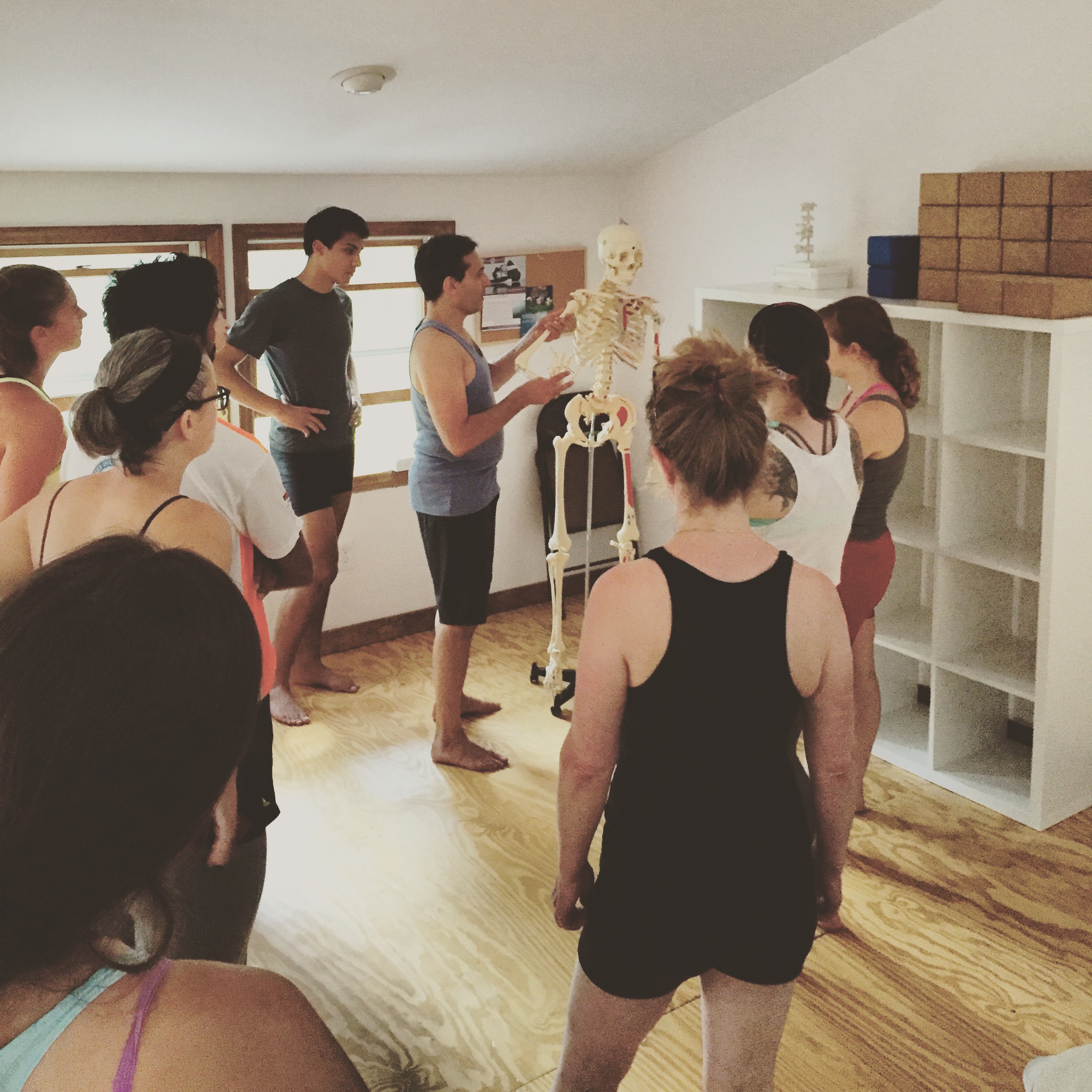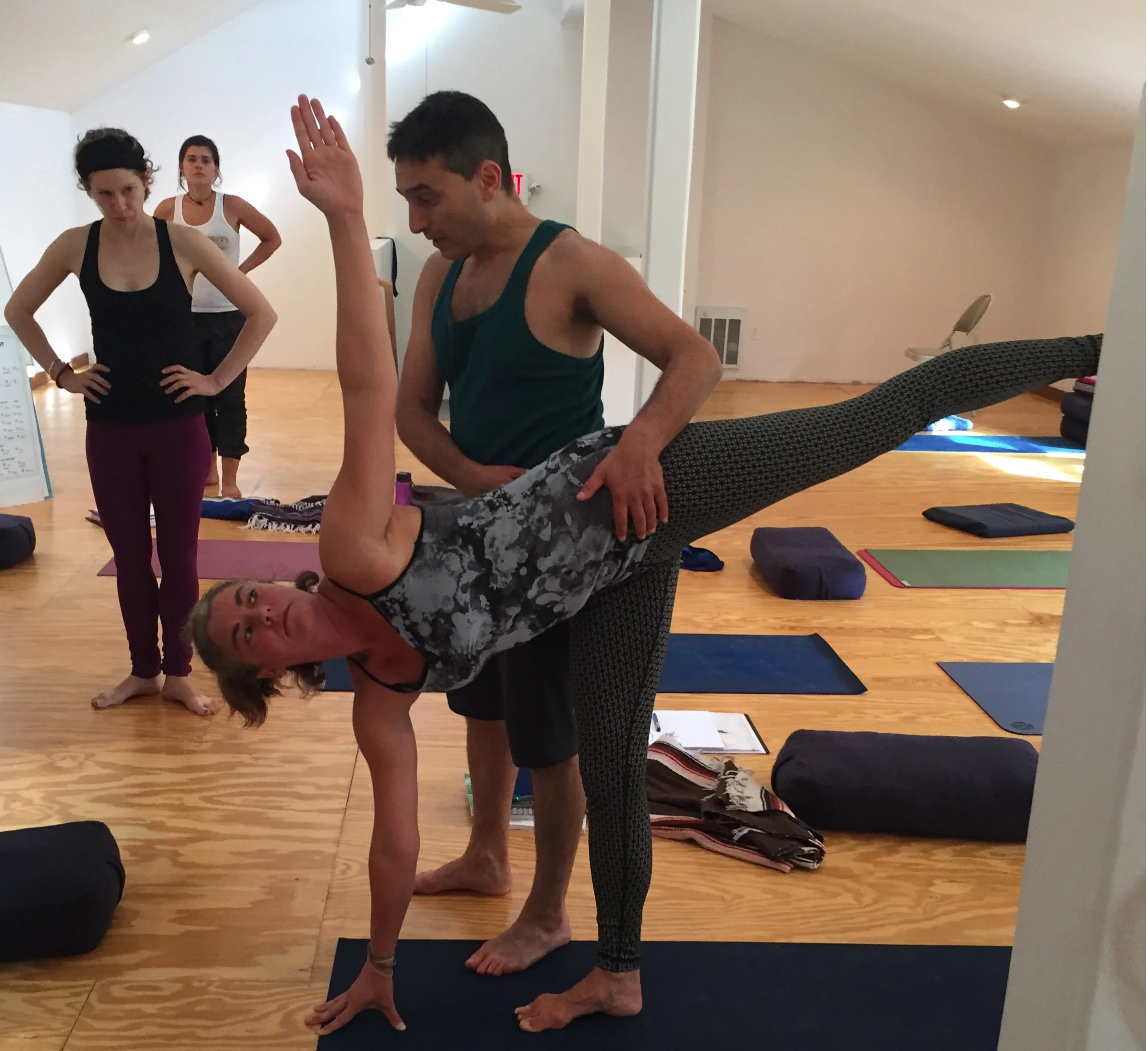Ananda Ashram Yoga Teacher Training
NEW modular training | March - June 2020
3 weekends per month through March–May
2 weekends in June, including graduation
March 7-8 + 21-22 + 28-29
April 4-5 + 18-19 + 25-26
May 2-3 + 16-17 + 23-24
June 6-7 + 13-14
Tuition $3000
plus overnight ashram accommodations or commuter fees
Course Syllabus
Asana
Personal practice is the root of understanding asana. Every day of the training will begin with Mysore-style Ashtanga Yoga practice incorporating contemporary variations to support each students' individual needs. We will learn practices that use the wall, yoga blankets, blocks, bolsters, chairs and, of course, our yoga mats. The art of verbal and hands-on assists, class sequencing and variations of poses for students with differing needs will all be covered in a workshop format, giving each participant ample time to practice new skills. Pranayama (breath work), kriyas (techniques for purification and awakening energy), mudras (energetic seals made by the fingers, hands and limbs), bandhas (energetic locks in the body) and relaxation techniques will all be explored.
Our integrated approach is designed to provide students with a solid foundation for their personal practice and for sharing yoga with others. Individualized instruction, group practice and inspiring presenters fulfill a curriculum that empowers students to create a safe space that promotes resilience, healing and relaxation. Through interactive exercises we will explore the many skills involved in leading a class. This is a unique program that challenges and inspires participants on many levels, developing our strength, balance and a deeper understanding of our own potential.
Meditation & Scripture Studies
We begin our day together with meditation in silence and spiritual studies and practices. These are the foundation of ashram life, providing inner nourishment and renewal as well as spiritual education as they support and stabilize us in the discovery of our own natural state of clarity, harmony, unity and self awareness.
Group meditation generally begins with a simple form of Vedic fire ceremony which is offered for world peace and individual and planetary healing. This includes chanting Sanskrit mantras followed by a period of silent meditation.
In our 200-hour Yoga Teacher Training, we focus our studies primarily on Patanjali’s Yoga Sutras and the Bhagavad Gita. These important texts form the foundation of the science of Yoga and Vedantic philosophy. The sutras and mantras come to life through the vibration of Sanskrit chanting, word-by-word translation, examination of commentaries and discussion of their relevance in our life and our world. The combination of a meditative approach, with clarification of the philosophical context and direct insights from the ancient Sanskrit language, illuminates the inner meaning of the scriptures, their significance for healing and self realization. Another important text we will study is Fundamentals of Yoga, written by our Founder Shri Brahmananda Sarasvati in 1959.
Sanskrit Studies
A special feature of our Yoga Teacher Training is a direct approach to the ancient teachings of Yoga and Vedanta through study of the Sanskrit language. Shri Brahmananda Sarasvati or "Guruji," as his students refer to him, was a recognized master of the language and ignited a love of Sanskrit at Ananda Ashram. In his teaching he prominently used the medium of Sanskrit, emphasizing chanting and study of mantras, hymns and scriptural texts as well as study of the language itself as the “science of vibration.”
Chanting Sanskrit is a powerful medium for transformation. This course emphasizes accurate Sanskrit pronunciation supported by chanting the Sanskrit alphabet and reading and writing the ancient devanagari Sanskrit script. With these skills, students acquire confidence in pronunciation of the yoga asana names and access to their meaning and the philosophy and stories behind them.
Even an introductory knowledge of Sanskrit conveys a feeling for the language and facilitates access to the spirit and meaning of the ancient scriptures. In Guruji's tradition, our lively, interactive method of chanting brings this ancient language of pure sound vibration to life. Creative Sanskrit homework assignments also reinforce our interdisciplinary course studies, including terminology, sutras and mantras from the Yoga Sutras, Bhagavad Gita and Sankhya-Yoga philosophy.
Applied Anatomy & Physiology
The anatomy and physiology component of our training uses movement, palpation and interactive learning to help students develop an experiential sense of the body’s anatomical structures. We learn basic anatomical terms to describe the body and its movement and we explore the roles of different body tissues, particularly bones, muscles and connective tissue, to gain an understanding of how they come together to form an integral living organism. Emphasis is placed on the anatomy of the breath as well as the spine, hip and shoulder joints. Technical material is oriented to explore the concepts and their relationship to yoga asana. Class time includes lecture, demonstration, hands-on partner work, body reading, movement, play and asana practice as we explore the many exciting facets of the human body.
Teaching Methodology
An important part of this group experience is learning to listen to constructive feedback and helping to guide and support others in their learning process. In this process, we gain confidence in our own voice and develop perceptual and communication skills.
Our program offers students guidelines for teaching yoga in both one-to-one and group class settings. Working with each other to practice assisting in poses and manual adjustments of postures is an important part of these interactive sessions. Effective and practical methods for teaching, the business and ethics of teaching, and the student-teacher process and relationship are discussed. Developing teaching skills and the ability to articulate teaching instructions clearly and succinctly is another important aspect of our group experience. Constructive feedback and helping to guide and support others in their learning process is one of the great benefits of working together as a group.
Some of the subjects we explore in our teaching practicums include:
how to plan a one-to-one private class
how to plan a group class
talking through the alignment of poses
hands-on assists of postures
the business and ethics of teaching
the student-teacher process and relationship.
community building
learning to work with groups of people
body reading in the poses
and much more.
Prenatal Yoga
In this introductory workshop, students learn modifications of yoga postures, use of props, breathing techniques and other helpful information to support pregnant mothers through the changing phases of pregnancy.
Nada Yoga
The East-West School of Music offers a one-day Nada Yoga retreat, which is a special highlight of our program. This day will guide students to deeply restorative and intuitive states through intervals of sitar music, meditation and silence.
Nada Yoga is an ancient science of awareness that utilizes the sacred music of India as a way to harmonize and still the mind, balance body chemistry and transform states of awareness. This full day of contemplative silence offers students a profound time in which to assimilate the insights and experiences of their journey and prepare for their final weeks of training.
General Information
Course Prerequisites
Ananda Ashram Yoga Teacher Training is an experience involving discipline and dedication. A basic knowledge of yoga postures, a sincere desire to learn and an openness to the classical teachings of yoga are required. A preliminary knowledge of yoga philosophy is also helpful.
Course Completion
The Ananda Ashram Yoga Teacher Training program consists of more than 200 classroom contact hours with experienced faculty and select guest teachers who are respected authorities in their fields. A 200-hour certification is granted following successful completion of the training. The program is Yoga Alliance registered (RYS-200 ID #40385 ).
Required Texts
Texts by Shri Brahmananda Sarasvati, Ashram Founder & Guru
• The Yoga Sutras of Patanjali: Sanskrit Text with Translation (manual)
• The Yoga Sutras of Patanjali: Healing Through Chanting (CD set)
• Fundamentals of Yoga: A Handbook of Theory, Practice & Application
• Nada Yoga: The Science, Psychology & Philosophy of Anahata Nada Yoga
Texts by Other Authors
• The Heart of Yoga – T.K.V. Desikachar
• The Complete Book of Vinyasa Yoga – Srivatsa Ramaswami
• Ashtanga Yoga: The Practice Manual – David Swenson
• The Concise Book of the Moving Body – Chris Jarmey & Thomas Myers
• Illustrated Essentials of Musculoskeletal Anatomy (5th edition*) – Kay W. Sieg & Sandra P. Adams * (Be sure to specify 5th edition)
Recommended Texts
• The Textbook of Yoga Psychology: A Definitive Translation & Interpretation of Patanjali’s Yoga Sutras – Shri Brahmananda Sarasvati
• Yoga & Meditation for Self Healing – Shri Brahmananda Sarasvati
• Yoga Anatomy (2nd edition) – Leslie Kaminoff
Publications by Shri Brahmananda Sarasvati are available from the Baba Bhagavandas Publication Trust and sold at the Ananda Ashram Gift Shop. Enrolled YTT students will receive a 10% discount when ordering Shri Brahmananda Sarasvati's publications directly from the Baba Bhagavandas Publication Trust. Place your order by emailing orders@babatrust.org, including name, postal mailing address, titles and quantities requested, and whether you wish to include insurance. All orders will be sent USPS priority ground mail.
For more information about Ananda Ashram Yoga Teacher Training,
please contact anandaashramyoga@gmail.com.




